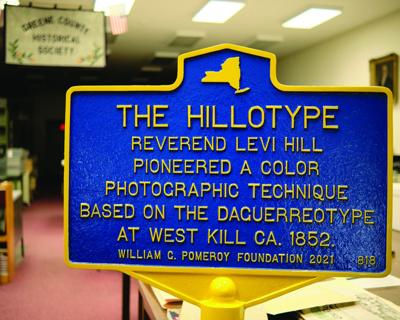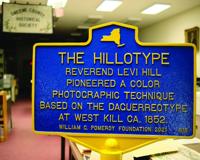I’m still not over the novelty of receiving roadside history markers in the mail. It’s odd to see one of those blue and gold metal signs freshly wrapped in its packaging sitting in a box instead of faded, rusting, and askew on a post at the side of the highway. After many years spent enthusiastically reading these roadside markers it is doubly odd to receive one which has text on it which I wrote. Is this what historians do? They write roadside markers to trick future generations into liking history? (What came first: the historian or the roadside marker?)
Philosophical questions about my profession aside, New York State History Markers are no longer a project funded by New York State. Instead, the private William G. Pomeroy Foundation funds the creation of these markers in a yearly application cycle. The process is simple enough, but the Pomeroy foundation requires applicants to give primary sources proving the veracity of proposed marker text. Back in the 1930s when New York State began its program the process wasn’t quite as rigorous, and some roadside markers from the ‘30s offer dubious claims and commemorate rather strange things. The most curious old marker I’ve seen is on Route 145 in Preston Hollow and commemorate’s the town whipping post of all things.
This new marker is only the second one I’ve done, which makes me a relative newcomer compared with other local historians I know. The new marker celebrates the Hillotype, which may be the earliest photographic process in history which authentically captured color for posterity. The Hillotype is named for its inventor Levi Hill, though he himself called his technique “Heliochromy” in a book he wrote on the subject in 1856. Hill experimented with his process at West Kill from the late 1840s into the 1850s, and in 1852 Samuel Morse observed and wrote of Hill’s progress to much fanfare. James Maxwell’s three-color process, long held to be the first color photographic technique, wasn’t proposed until 1855.
The complicated nature of Hill’s Process, coupled with his failure to disclose the precise recipe and his tendency to “enhance” certain images with other colors afterwards led his work to be dismissed as a fraud for well over a century. Renewed interest in Hill’s work in the 1980s and 1990s by photography experts and the Smithsonian finally determined that his process indeed replicated some true colors at the moment the image was exposed — thus redeeming Levi Hill’s legacy and making the hamlet of West Kill in Lexington, New York the birthplace of color photography.
Levi Hill’s life is of considerable interest even discounting his pioneering photographic work. Born in Athens, he spent time in the publishing business in Hudson and Kingston as well as New York before becoming a Baptist minister. His work in the Baptist Church took him up and down the Hudson Valley, and he preached for a time in New Baltimore before finding his way to West Kill. His ministry in the Catskills was a busy one, and he published a journal called the Christian Repository for a time before leaving West Kill in the midst of the Anti-Rent War. He had been accused of favoring the up-renters, and delivered a heated sermon decrying the tactics of his down-renter parishioners before fleeing to Saugerties for several years. An infection which resulted in his voice being too weak to preach led him to take up the art of the Daguerreotype, and his work as a Daguerreotypist resulted in his fascination with discovering a color photographic process.
Once the post for this new roadside marker is set I’ll be driving it up to Lexington for an unveiling ceremony. Stay tuned for upcoming announcements of the date and time for that event as well as the unveiling ceremonies for other markers in our area!
As always, questions and comments can be directed to me via archivist@gchistory.org.
Johnson Newspapers 7.1









